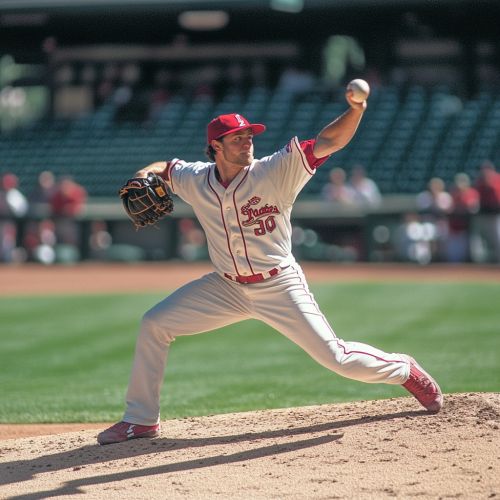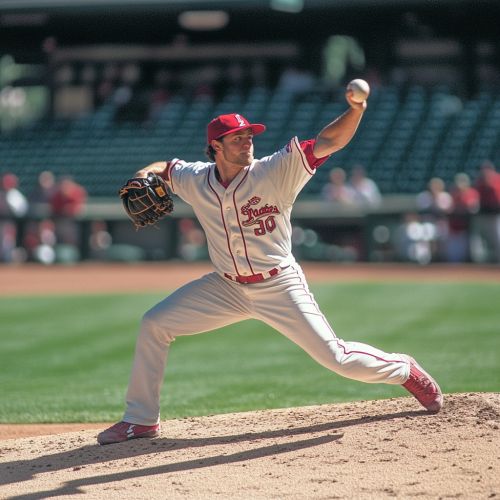Baseball Pitching: Difference between revisions
(Created page with "== Introduction == Baseball pitching is a fundamental aspect of the sport of baseball, involving the act of throwing a baseball towards the catcher to begin a play. The pitcher, positioned on the pitcher's mound, aims to deliver the ball in a manner that makes it difficult for the batter to hit. This article delves into the mechanics, types, strategies, and historical evolution of baseball pitching, providing a comprehensive understanding for enthusiasts and scholars...") |
No edit summary |
||
| Line 38: | Line 38: | ||
The knuckleball is a unique pitch that relies on minimal spin, causing erratic movement. It is thrown with the fingertips, creating a floating effect that makes it difficult for batters to predict its trajectory. The knuckleball is challenging to master but can be highly effective. | The knuckleball is a unique pitch that relies on minimal spin, causing erratic movement. It is thrown with the fingertips, creating a floating effect that makes it difficult for batters to predict its trajectory. The knuckleball is challenging to master but can be highly effective. | ||
[[Image:Detail-97501.jpg|thumb|center|A baseball pitcher in mid-throw on a professional baseball field.|class=only_on_mobile]] | |||
[[Image:Detail-97502.jpg|thumb|center|A baseball pitcher in mid-throw on a professional baseball field.|class=only_on_desktop]] | |||
== Pitching Strategies == | == Pitching Strategies == | ||
Latest revision as of 04:42, 6 August 2024
Introduction
Baseball pitching is a fundamental aspect of the sport of baseball, involving the act of throwing a baseball towards the catcher to begin a play. The pitcher, positioned on the pitcher's mound, aims to deliver the ball in a manner that makes it difficult for the batter to hit. This article delves into the mechanics, types, strategies, and historical evolution of baseball pitching, providing a comprehensive understanding for enthusiasts and scholars alike.
Mechanics of Pitching
The mechanics of pitching involve a complex sequence of movements that require precise coordination and physical conditioning. The process can be broken down into several key phases:
Windup
The windup is the initial phase where the pitcher prepares to throw the ball. It involves a series of movements designed to generate momentum and power. The pitcher starts with both feet on the rubber, then steps back with the non-pivot foot, raising the hands above the head or to the chest, and shifting weight to the pivot foot.
Stride
In the stride phase, the pitcher takes a step forward with the lead foot towards home plate. This action helps to transfer the body's kinetic energy into the throw. The stride length and direction are crucial for maintaining balance and control.
Arm Action
The arm action phase involves the movement of the pitching arm from the cocked position to the release point. The arm should follow a smooth, circular path, with the elbow leading the motion. Proper arm action is essential for velocity and accuracy.
Release
The release point is where the ball leaves the pitcher's hand. It is critical for determining the pitch's trajectory and speed. The wrist should snap forward, imparting spin on the ball, which influences its movement.
Follow-Through
The follow-through phase involves the continuation of the pitcher's motion after releasing the ball. This phase helps to dissipate the energy generated during the throw and reduces the risk of injury. The pitcher should finish in a balanced position, ready to field the ball if necessary.
Types of Pitches
Pitchers use a variety of pitches to challenge batters, each with unique characteristics and purposes. The main types of pitches include:
Fastball
The fastball is the most common pitch, known for its speed. It is thrown with maximum velocity, typically ranging from 85 to 100 mph. Variations include the four-seam fastball, which is straight and fast, and the two-seam fastball, which has slight movement due to the grip.
Curveball
The curveball is a breaking pitch that features a significant downward and lateral movement. It is thrown with a grip that imparts topspin, causing the ball to drop as it approaches the plate. The curveball's effectiveness lies in its ability to deceive batters with its sharp break.
Slider
The slider is a hybrid pitch, combining elements of the fastball and curveball. It has a lateral movement with a slight downward break, making it difficult for batters to hit. The slider is thrown with a grip that creates a spinning motion, resulting in its characteristic movement.
Changeup
The changeup is an off-speed pitch designed to look like a fastball but arrives at the plate much slower. It is typically thrown with the same arm action as a fastball, but with a different grip that reduces velocity. The changeup's effectiveness lies in disrupting the batter's timing.
Knuckleball
The knuckleball is a unique pitch that relies on minimal spin, causing erratic movement. It is thrown with the fingertips, creating a floating effect that makes it difficult for batters to predict its trajectory. The knuckleball is challenging to master but can be highly effective.


Pitching Strategies
Pitching strategies involve the tactical use of different pitches and techniques to outsmart batters. Key strategies include:
Pitch Sequencing
Pitch sequencing refers to the order in which pitches are thrown. Effective sequencing keeps batters off-balance by varying pitch types, speeds, and locations. For example, a pitcher might follow a high fastball with a low curveball to exploit the batter's changing eye level.
Location Control
Control of pitch location is crucial for success. Pitchers aim to throw to specific areas of the strike zone to exploit a batter's weaknesses. Common targets include the corners of the plate, the high inside corner, and the low outside corner.
Deception
Deception involves using techniques to disguise the type of pitch being thrown. This can include altering the pitcher's delivery, using similar arm actions for different pitches, and varying the timing of the windup. Deception makes it harder for batters to anticipate and react to pitches.
Situational Pitching
Situational pitching refers to adapting pitch selection based on the game context. Factors such as the count, the number of outs, base runners, and the batter's tendencies influence the pitcher's decisions. For example, with two strikes, a pitcher might use a breaking ball to induce a swing and miss.
Historical Evolution
The art of pitching has evolved significantly since the inception of baseball. Early pitchers relied primarily on fastballs and basic breaking pitches. Over time, advancements in training, technology, and understanding of biomechanics have led to the development of more sophisticated pitches and techniques.
Early Baseball
In the early days of baseball, pitchers threw underhand and focused on accuracy rather than speed. The introduction of overhand pitching in the late 19th century revolutionized the game, allowing for greater velocity and movement.
Dead-Ball Era
During the Dead-Ball Era (1900-1919), pitchers dominated the game with low-scoring contests. The emphasis was on control and deception, with pitchers like Cy Young and Walter Johnson becoming legends for their prowess.
Live-Ball Era
The Live-Ball Era (1920-present) saw an increase in offensive production, prompting pitchers to develop new strategies and pitches. The introduction of the slider, split-finger fastball, and other advanced pitches helped pitchers adapt to the changing landscape.
Modern Pitching
Modern pitching is characterized by a scientific approach, with extensive use of video analysis, biomechanics, and data analytics. Pitchers like Nolan Ryan, Randy Johnson, and Clayton Kershaw have set new standards for excellence, combining power, precision, and innovation.
Training and Conditioning
Effective pitching requires rigorous training and conditioning to develop strength, flexibility, and endurance. Key components include:
Strength Training
Strength training focuses on building the muscles used in pitching, particularly the shoulders, arms, and core. Exercises such as weightlifting, resistance bands, and plyometrics help increase power and stability.
Flexibility
Flexibility is essential for a full range of motion and injury prevention. Stretching routines, yoga, and dynamic warm-ups improve flexibility and prepare the body for the demands of pitching.
Endurance
Endurance training enhances a pitcher's ability to maintain performance over long periods. Cardiovascular exercises, interval training, and long-distance running build stamina and reduce fatigue.
Mental Conditioning
Mental conditioning is crucial for focus and resilience. Techniques such as visualization, meditation, and mindfulness help pitchers stay calm under pressure and maintain concentration.
Injuries and Prevention
Pitching places significant stress on the body, leading to a risk of injuries. Common injuries include:
Rotator Cuff Injuries
The rotator cuff is a group of muscles and tendons that stabilize the shoulder. Overuse or improper mechanics can lead to strains, tears, and inflammation. Prevention involves proper warm-ups, strength training, and monitoring pitch counts.
Ulnar Collateral Ligament (UCL) Injuries
UCL injuries, often requiring Tommy John surgery, are common among pitchers due to the repetitive stress on the elbow. Prevention includes proper mechanics, avoiding overuse, and incorporating rest periods.
Shoulder Impingement
Shoulder impingement occurs when the tendons of the rotator cuff become compressed. It can result from poor mechanics or overuse. Prevention involves maintaining flexibility, strength, and proper pitching technique.
Tendinitis
Tendinitis is the inflammation of tendons, commonly affecting the elbow and shoulder. It results from repetitive motion and overuse. Prevention includes adequate rest, proper mechanics, and conditioning.
See Also
References
- No references available.
